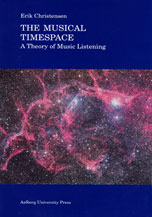The Musical TimespaceA Theory of Music Listening
Hearing is not designed for music listening
Hearing is designed for survival in a natural environment, permitting the auditory perception of sound sources, movements and spatial relations in the surrounding world. Five listening dimensions provide a basis for orientation in the natural environment: Intensity, Timbre, Space, Movement and Pulse.
Music evokes a virtual space in the listening mind
When music attracts auditory attention, a competition arises between the musical sounds and the sounds of the surrounding world. If the music drowns out other kinds of sound, the musical sounds engage the potential of auditory perception to such a degree that ordinary auditory spatial consciousness is suppressed. The auditory images of the world are eliminated, and a virtual musical space is evoked in the listening mind.

